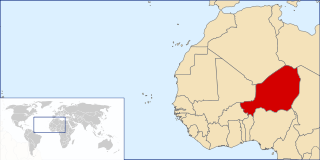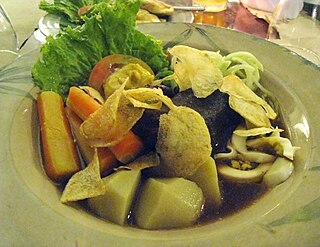Related Research Articles

Apple sauce is a purée made of apples. It can be made with peeled or unpeeled apples and can be spiced or sweetened. Apple sauce is inexpensive and is widely consumed in North America and some parts of Europe.

Scotch bonnet is a variety of chili pepper named for its supposed resemblance to a Scottish tam o' shanter bonnet. It is ubiquitous in West Africa and the Caribbean.

The cuisine of Senegal is a West African cuisine that derives from the nation's many ethnic groups, the largest being the Wolof and is French influenced. Islam, which first embraced the region in the 11th century, also plays a role in the cuisine. Senegal was a colony of France until 1960. From the time of its colonization, emigrants have brought Senegalese cuisine to many other regions.

Beef tongue is a cut of beef made of the tongue of a cow. It can be boiled, pickled, roasted or braised in sauce. It is found in many national cuisines, and is used for taco fillings in Mexico and for open-faced sandwiches in the United States. In France and Belgium it is served with Madeira sauce, while chrain is the preferred accompaniment in Ashkenazi and Eastern European cuisines. Germans make white roux with vinegar and capers, or horseradish cream, which is also popular in Polish cuisine.

Peanut stew or groundnut stew, also known as maafe, sauce d'arachide (French) or tigadèguèna is a stew that is a staple food in Western Africa. While maafe is a dish originating in Senegal, tigadéguéna originates from the Mandinka and Bambara people of Mali.

Siomay, is an Indonesian steamed fish dumpling with vegetables served in peanut sauce. It is derived from the Chinese Shumai. It is considered a light meal, similar to the Chinese dim sum. It is traditionally made from pork but is frequently substituted with tenggiri, as many Indonesians observe the halal dietary law. Sometimes other types of seafood such as tuna, mackerel, and prawn also can be used to make siomay. Other complements to siomay include steamed cabbage, potatoes, bitter gourd, boiled egg, and tofu. Siomay is often cut into bite-size pieces and topped with peanut sauce, sweet soy sauce, chili sauce, and a dash of lime juice.

West African cuisine encompasses a diverse range of foods that are split between its 16 countries. In West Africa, many families grow and raise their own food, and within each there is a division of labor. Indigenous foods consist of a number of plant species and animals, and are important to those whose lifestyle depends on farming and hunting.

The cuisine of Equatorial Guinea is a blend of the cuisines of the native peoples of this African country, including the Annobonese, the Bubi, the Fang, and the Kombe. It is also influenced by the cuisines of Spain ; other African nations such as Nigeria and Cameroon; Islamic states such as Morocco; and Creole cuisine overall. Its cuisine incorporates various meats, including game and bushmeat as well as imports, and is known for its strong flavors and high spice levels. Fish and chicken are common dishes.

Bolognese sauce, known in Italian as ragù alla bolognese or ragù bolognese, is a meat-based sauce in Italian cuisine, typical of the city of Bologna. It is customarily used to dress tagliatelle al ragù and to prepare lasagne alla bolognese.

Ivorian cuisine is the traditional cuisine of Côte d'Ivoire, or the Ivory Coast, and is based on tubers, grains, pig, chicken, seafood, fish, fresh fruits, vegetables and spices. It is very similar to that of neighboring countries in West Africa. Common staple foods include grains and tubers. Côte d'Ivoire is one of the largest cocoa producers in the world and also produces palm oil and coffee.

The cuisine of Niger draws on traditional African cuisines. Various spices are used and meals include grilled meat, seasonal vegetables, salads, and various sauces. Meals in Niger usually start with colorful salads made from seasonal vegetables. Moringa leaves are a favorite for a salad.

Togolese cuisine is the cuisine of the Togolese Republic, a country in Western Africa. Staple foods in Togolese cuisine include maize, rice, millet, cassava, yam, plantain and beans. Maize is the most commonly consumed food in the Togolese Republic. Fish is a significant source of protein. People in Togo tend to eat at home, but there are also restaurants and food stalls.

The cuisines of Oceania include those found on Australia, New Zealand, and New Guinea, and also cuisines from many other islands or island groups throughout Oceania.

Guinean cuisine includes traditional Guinean dishes such as fou fou, boiled mango, fried plantains, patates and pumpkin pie.

The cuisine of Mauritania includes the culinary practices of Mauritania. Historically, what is now Mauritania has been influenced by Arab, Berbers and African peoples who have lived in and traversed the "stark" landscape marked with Sahara desert dunes in caravans. There is an overlap with Moroccan cuisine in the north and Senegalese cuisine in the south.

Selat solo is a Javanese dish influenced by Western cuisine; it is a specialty of Solo city, Central Java, Indonesia. It consists of braised beef tenderloin served in thin watery sauce made from a mixture of garlic, vinegar, kecap manis, Worcestershire sauce, water, and spiced with nutmeg and black pepper. It is served with hard boiled egg and vegetables such as string beans, potato, tomato, lettuce, cucumber, cauliflower or broccoli and carrot, and topped with potato chips and some dash of mustard, hollandaise or sauce gribiche on the side.

Crab in oyster sauce or oyster sauce crab is a Chinese seafood dish of crab served in savoury oyster sauce. It is a popular dish in Asia, that can be found from China, Indonesia, Singapore to the Philippines.

Chinese bhel is a fast food and street food item in India and is considered a part of Indo-Chinese cuisine. It is a variant of chop suey and bhelpuri. It is popular in Mumbai.

Almadroc is a garlic-cheese sauce from medieval Catalan cuisine from the Llibre de Sent Soví. There is a similar recipe in the Llibre del Coch by Rupert de Nola for almadrote, a similar recipe for a sauce made with garlic, eggs, cheese and broth that was served with partridge. In modern usage it refers to an oil, garlic and cheese sauce served with eggplant casserole. Almadrote may have pre-Inquisition Sephardic origins and served with eggplant has become widespread in modern Turkish cuisine.
References
- ↑ "Footi Sauce à la Nene Galle Diallo Recipe from Senegal". Celtnet Recipes. Archived from the original on April 4, 2015. Retrieved December 24, 2023.